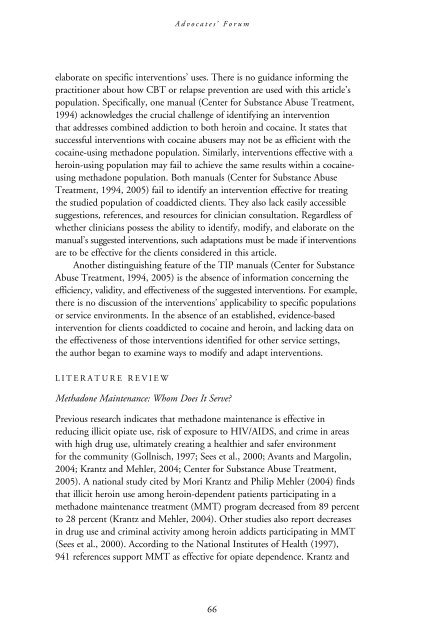2006 - School of Social Service Administration - University of Chicago
2006 - School of Social Service Administration - University of Chicago
2006 - School of Social Service Administration - University of Chicago
You also want an ePaper? Increase the reach of your titles
YUMPU automatically turns print PDFs into web optimized ePapers that Google loves.
Advocates’ Forum<br />
elaborate on specific interventions’ uses. There is no guidance informing the<br />
practitioner about how CBT or relapse prevention are used with this article’s<br />
population. Specifically, one manual (Center for Substance Abuse Treatment,<br />
1994) acknowledges the crucial challenge <strong>of</strong> identifying an intervention<br />
that addresses combined addiction to both heroin and cocaine. It states that<br />
successful interventions with cocaine abusers may not be as efficient with the<br />
cocaine-using methadone population. Similarly, interventions effective with a<br />
heroin-using population may fail to achieve the same results within a cocaineusing<br />
methadone population. Both manuals (Center for Substance Abuse<br />
Treatment, 1994, 2005) fail to identify an intervention effective for treating<br />
the studied population <strong>of</strong> coaddicted clients. They also lack easily accessible<br />
suggestions, references, and resources for clinician consultation. Regardless <strong>of</strong><br />
whether clinicians possess the ability to identify, modify, and elaborate on the<br />
manual’s suggested interventions, such adaptations must be made if interventions<br />
are to be effective for the clients considered in this article.<br />
Another distinguishing feature <strong>of</strong> the TIP manuals (Center for Substance<br />
Abuse Treatment, 1994, 2005) is the absence <strong>of</strong> information concerning the<br />
efficiency, validity, and effectiveness <strong>of</strong> the suggested interventions. For example,<br />
there is no discussion <strong>of</strong> the interventions’ applicability to specific populations<br />
or service environments. In the absence <strong>of</strong> an established, evidence-based<br />
intervention for clients coaddicted to cocaine and heroin, and lacking data on<br />
the effectiveness <strong>of</strong> those interventions identified for other service settings,<br />
the author began to examine ways to modify and adapt interventions.<br />
LITERATURE REVIEW<br />
Methadone Maintenance: Whom Does It Serve?<br />
Previous research indicates that methadone maintenance is effective in<br />
reducing illicit opiate use, risk <strong>of</strong> exposure to HIV/AIDS, and crime in areas<br />
with high drug use, ultimately creating a healthier and safer environment<br />
for the community (Gollnisch, 1997; Sees et al., 2000; Avants and Margolin,<br />
2004; Krantz and Mehler, 2004; Center for Substance Abuse Treatment,<br />
2005). A national study cited by Mori Krantz and Philip Mehler (2004) finds<br />
that illicit heroin use among heroin-dependent patients participating in a<br />
methadone maintenance treatment (MMT) program decreased from 89 percent<br />
to 28 percent (Krantz and Mehler, 2004). Other studies also report decreases<br />
in drug use and criminal activity among heroin addicts participating in MMT<br />
(Sees et al., 2000). According to the National Institutes <strong>of</strong> Health (1997),<br />
941 references support MMT as effective for opiate dependence. Krantz and<br />
66
















